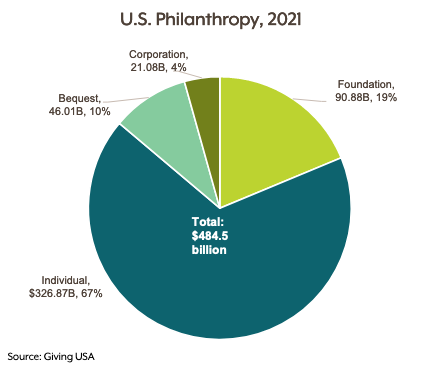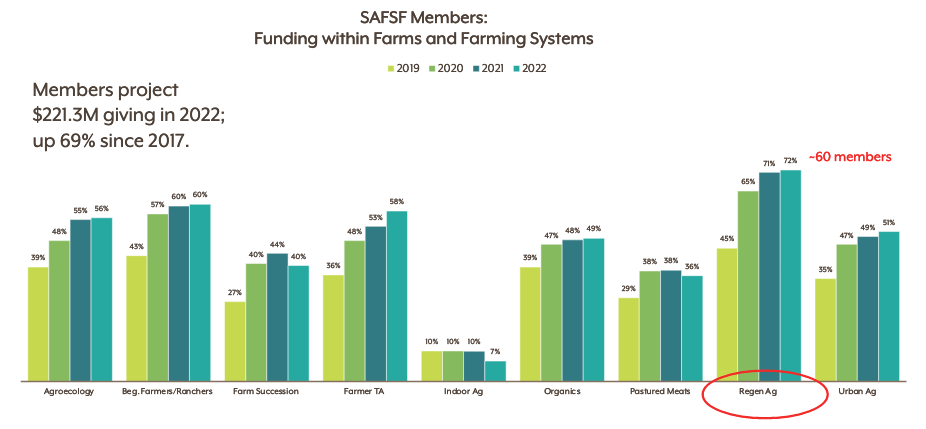Throughout 2022, RFSI News has explored the role that different types of capital – including debt, private equity, and venture capital – can play in enabling regenerative food systems. Another source of capital – philanthropic capital – plays a unique and growing role in funding the regeneration of food systems, in part by de-risking investments in what is still a relatively nascent space. In her presentation at the 2022 RFSI Forum, Sarah Kelley of Common Thread Consulting and Sustainable Agriculture and Food Systems Funders (SAFSF) explored the universe of philanthropic capital and the role it plays in today’s food and fiber systems, as well as some of the ways we can continue to expand its role.
The Philanthropic Capital Universe
Philanthropic capital is funding delivered as either a gift with no expectation of financial return or an asset with a less than market rate return-on-investment (ROI), that is intended to generate social impact. The most common source of philanthropic capital is grants, which are most often given out by foundations, corporations, or government agencies.
In 2021, philanthropy in the U.S. accounted for $484.5 billion, which is only a small fraction of the estimated $17.1 trillion in sustainable investing assets, as measure by US SIF. Despite being only a small fraction of sustainable investing assets in 2021, Kelley explains that philanthropy is important to discuss because it can be some of the most flexible, risk tolerant, and catalytic capital available.
In her presentation at the 2022 RFSI Forum, Sarah Kelley explored the universe of philanthropic capital through the lens of private foundations – which makes up about 19% or $91 billion of the $484.5 billion in 2021 philanthropy. She explained that foundations must, by definition, distribute about 5% of their assets every year. This distribution is limited by the fact that most private and community foundations fall under 501(c)(3) charitable organizations which means that tax codes set the funding constraints and are a major driver of what the money can be used for and what type of organization it can go to.

Philanthropic Capital for Regenerative Food Systems
In the past five years, we have seen more capital flowing to regenerative food systems in general and philanthropic funding follows this trend. Kelley shares a representative sample of this from her organization SAFSF, which is made up of approximately 100 private foundations, individual investors, regranting organizations, community foundations, corporate foundations, bank/trust/philanthropic advisors. She shares that member project giving in 2022 reached $221.3 million, up 69% since 2017. According to member reported data, in 2022 giving across farms and farming systems increased overall and regenerative agriculture was the largest area of giving and among the fastest growing.

The Role of Philanthropic Capital
In general, philanthropic capital in the form of grants is more risk tolerant than other forms of capital and therefore it can play a critical role in funding projects that are presently being overlooked and in de-risking projects for future investment. Kelley outlines five roles philanthropic capital can play in regenerative food system funding today. These include:
- Non-dilutive Capital: Philanthropy can serve as early stage, non-dilutive capital that supports R&D, feasibility studies, technical assistance and other roles to get companies further along and prepared for other types of investment.
- Infrastructure: As an underfunded space, grant capital can play a role in funding early-stage legal and permitting costs, as well as land and facility acquisition that would otherwise be risky for projects and other investors.
- Leverage: This is especially relevant when working with government and policy. Philanthropic capital can be used as matching funds to government grants or to fund policy advocacy to increase federal funding.
- New Tools: Again, serving in a de-risking role, philanthropic capital can fund pilots of new financial tools to support innovation in the instruments we use to fund regeneration and measure impact.
- Justice and Equity: Supporting communities and entrepreneurs who have been most deeply impacted by the extractive food system and providing capital to those that are under-served by the current financial system.
Who is Doing the Work?
In her presentation at the Forum, Kelley shares some compelling case studies of how philanthropic capital is being put to work to advance regenerative food and fiber, including The Intertribal Agriculture Council, The Tanka Fund, Island Foundation and others. She also sat down with Mark Watson of Potlikker Capital to discuss his organization’s social justice charitable loan fund and their efforts to support farmers of color who are under served by today’s farm finance system.
Beyond these examples, there are many other philanthropic funders working to activate regenerative agriculture through giving. Several organizations serve these funders in the space, including:
- Sustainable Agriculture and Food Systems Funders (SAFSF) works to amplify the impact of philanthropic and investor communities for a just and sustainable food and agriculture system.
- Funders of Regerative Agriculture (FORA) is a membership based organization that includes but is not limited to philanthropic foundations.
- Regenerative Food Systems Investment (RFSI) has launched a new Funder Directory that helps identify who is funding the space. Click on “Directory ” on the main menu to access.
The Opportunity to Do More with Philanthropy
While philanthropy can serve the regenerative space through the aforementioned roles, it’s also important to continue to ask what more can be done and how does philanthropy work within the larger regenerative food systems investment space. On this front, Kelley offers the following….
Remember, she explained that foundations are required to disburse 5% of assets each year, leaving 95% of foundations’ financial assets potentially untouched or invested outside the mission. One critique brought forward is that that perpetuates a system that shelters generational wealth and power. Instead, Kelley suggests there is opportunity to mobilize the remaining 95% of foundation assets – which accounts for an estimated $1.1-1.5 trillion – for investment regenerative food systems. Herein lies an opportunity for partnership between philanthropic funders and other investors to work together to mobilize this capital for efforts that further support the space.
—
To see the recording of this presentation and all the presentations from the 2022 RFSI Forum, please click here.
To reach Sarah Kelley, please contact her here.
To learn more about SAFSF, please visit: www.agandfoodfunders.org
Sarah Day Levesque is Managing Director at RFSI & Editor of RFSI News. She can be reached here.
